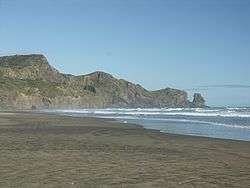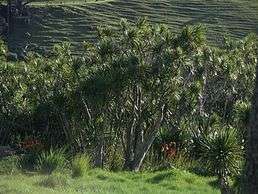Te Henga (Bethells Beach)
Coordinates: 36°53′25″S 174°27′05″E / 36.89028°S 174.45139°E

Te Henga (Bethells Beach) is a coastal community in the Auckland Region in the north of the North Island, New Zealand. The Māori name Te Henga, meaning sand, originally applied to a wide area of the lower Waitakere River valley, but in 1976 the New Zealand Geographic Board changed the name of the beach from Bethells Beach to Te Henga (Bethells Beach).[1]
The beach is approximately 30 kilometres north-west of Auckland City, at the mouth of the Waitakere River where it flows into the Tasman Sea. One of several popular resorts in the area (others include Muriwai, Piha and Karekare), it experiences a population explosion in summer when Aucklanders head to the sea.
History

The Te Henga Valley shows evidence of human settlement dating back over 1000 years. The cultural history of the area is of archaeologically significant sites, including food gathering areas, pā, walkways, canoe landings and sacred places.[1]
The arrival of Europeans in the 19th century led to major changes in the character and shape of Bethells Beach. The most significant of these changes was the clearing of the land for timber and pastoral farming which began in 1854 and continued until the 1920s. In addition, a dam was constructed on the Waitakere River in the 1920s, drastically altering the level of the riverbed and reducing the outflow of water to the sea.[1]
John Bethell negotiated with the Waitakere County Council to sell the land that is now known as Te Henga Park. The Council considered the beach and park area would provide excellent recreation facilities for residents of Auckland. Te Henga was recognised as a place of regional significance.[1]
Geology
The sand dunes have accumulated in several phases over the last 4,500 years. This accumulation has occurred since sea levels returned to about their present levels following the last glaciation 6,500 years ago. These sands contain quantities of black titanomagnetite derived from the volcanic rocks of Taranaki and carried north by coastal currents. The dunes continually move in a dynamic coastal process. There are three dune-impounded lakes: Lake Wainamu, Lake Kawaupaka and Lake Waiataru.
Ecology of the Waitakere River catchment

The Waitakere River catchment consists of roughly 70 km² of the bush-clad Waitakere Ranges. Located on the west coast of the Auckland Region approximately 75% of the catchment consists of native vegetation in spite of extensive milling, farming and settlement.
The major features of the catchment are:
- the abundance of native vegetation
- the steep and rugged terrain
- the Te Henga wetland
- the sand dunes
- Lake Wainamu
- The Waitakere Reservoir
The Waitakere River has two main tributaries, the Mokoroa and Waiti streams. The headwaters of the river are in the vast and steep Waitakere Ranges and drain out at the Bethell’s Beach river mouth.
In comparison with other North Island beaches, and to some extent even the west coast beaches of Muriwai and Piha, settlement at Bethells has been minor with most development revolving around horticulture and agriculture.
With the exception of the Waitakere Reservoir the catchments resources have largely escaped development.

In 1990 The Auckland Regional Water Board developed and prepared a Waitakere River Catchment Water and Soil Plan. This pre-Resource Management Act document aimed to deal with the competing water and soil resource demands within the catchment in terms of "conservation, allocation, use and quality of natural water and in terms of soil conservation and preventing damage from flooding." Although this document may be almost 16 years old many of its principles still apply.
Lake Wainamu is a dune lake that formed during the last 6,500 years when the Wainamu Stream Valley was dammed by dunes of sand blown inland. A decline in water quality was noted in 1990s and was thought to be caused by exotic fish accelerating the loss of the submerged plant life. In response the Auckland Regional Council removed over 9,000 exotic fish (particularly perch, goldfish and rudd) between 2004 and 2007.[2] In 2009, grass carp were introduced to the lake in an attempt to rid it of introduced egeria.[3] The lake is also home to native freshwater fish including banded kokopu, inanga, common smelt, common bully, grey mullet, longfin and short-finned eel.[2]
Activity
- Surfing is the main pastime. Other pastimes include parasailing and hang gliding, for which the prevailing westerly wind often provides favourable conditions.
- Fishing is also popular, although dangerous in many places and many deaths have taken place from this.
- Bush walking is encouraged, with boardwalks in place.
- Sunbathing, swimming, picnics, running etc.
- Skimboarding is also becoming quite popular with young people.
Filming location
The beach has been used as a filming location for several projects, one of the earliest being a four-month shoot for award-winning drama series Children of Fire Mountain (1979). Other shoots include the music video for Shania Twain single "Forever and for Always"(2003), "Out of the Woods" for Taylor Swift, TV series The New Adventures of Black Beauty, Brit/New Zealand TV movie The Man Who Lost His Head, and episodes of Xena: Warrior Princess, Young Hercules, and Hercules: The Legendary Journeys. Battle scenes for New Disney Channel Original movie Avalon High were also filmed there. In addition, K-pop singer Taeyeon's first solo music video I, and the end scenes of Crouching Tiger Hidden Dragon: Sword of Destiny were also filmed here.
Gallery
-

Fun in the lagoon
-

Bethell patterns
-

Cave
-

Shag
-

Burnt ablutions block
-

Surf lifesaving lookout
References
- 1 2 3 4 Te Henga Park Reserve Management Plan: Description of Te Henga Park, Waitakere City, June 2002.
- 1 2 "Lake Wainamu. Auckland Regional Council. Accessed 30 March 2009.
- ↑ "Army of fish to battle nasty weed". 24 March 2009. Auckland Regional Council. Accessed 30 March 2009.
External links
- Treasure Island Kids news
- Waitakere Govt site
- Surf Lifesaving website
- Map
- Photos
- More photos
- Surfing
- Bethells Beach and Xena film locations
- Bethells Beach Surf Life Saving Patrol
- Photographs of Te Henga held in Auckland Libraries' heritage collections.